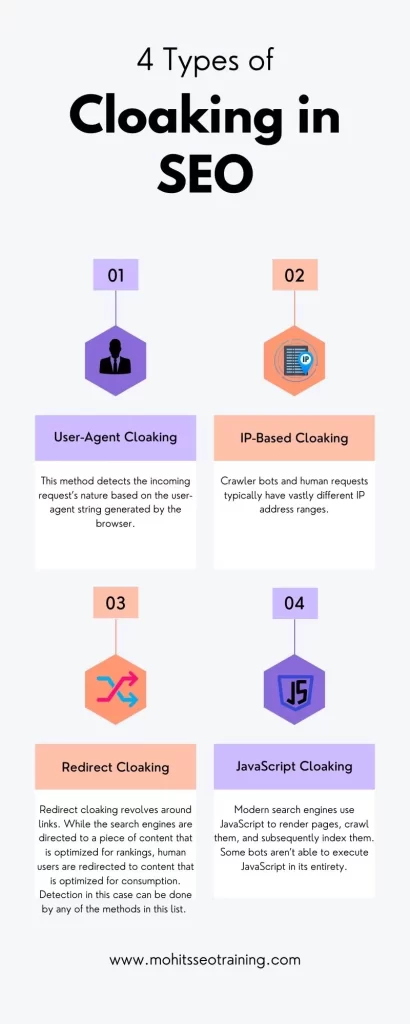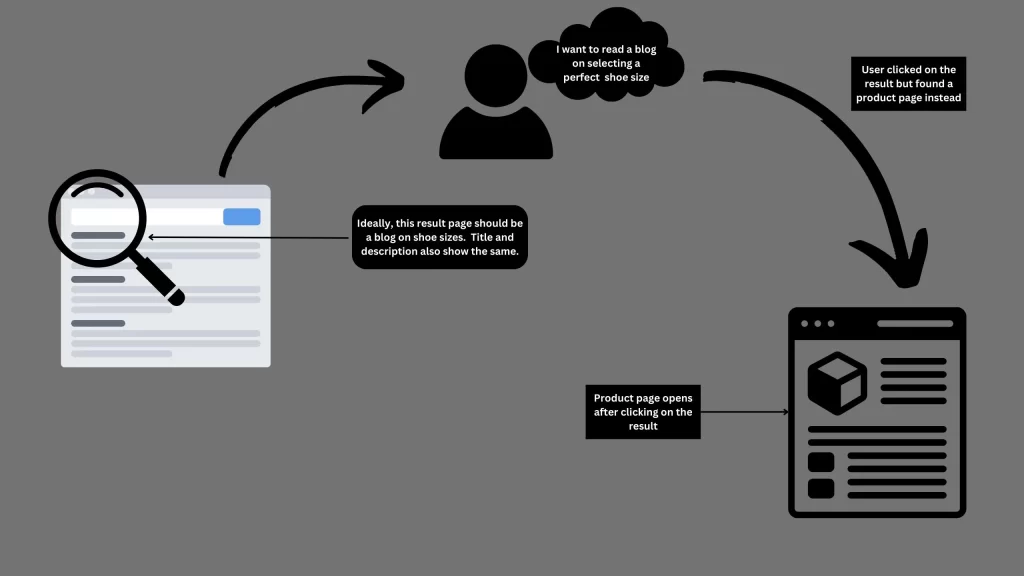A report from SEMrush in 2023 noted that approximately 30% of SEO practitioners have at some point tried or considered using risky tactics like cloaking. Not only that, A study by Search Engine Journal found that around 5% of websites using cloaking were penalized by Google in 2022.
Search Engine Optimization is an endeavor full of different tips and tricks. Lots of SEOs (Search Engine Optimizers) have figured out different creative ways to go about it. Now, some of these ways are deceptive and manipulative in nature. This is why Google, and other search engines, have framed many guidelines about what is allowed and what isn’t.
Adhering to these guidelines is an approach to SEO called the white hat SEO approach. On the contrary, SEOs who go against these guidelines and try to fool the search engines’ crawlers are said to be using an approach called the black hat SEO approach.
Cloaking is a black hat SEO approach that basically fools the search engines into thinking that a piece of content is there, when in actuality, some other version or no version at all exists for the users who visit the website.
This blog will comprehensively cover the fundamentals of cloaking in SEO, how to detect it, and what Google’s response to cloaking is. Let’s dive in!
Cloaking Meaning In SEO
Cloaking basically means putting a ‘cloak’ over the search engine crawlers’ eyes. It is the practice of showing different content to search engines than the one shown to human visitors. The content that is shown to the crawlers is highly optimized for keywords whereas the version shown to human visitors is different, and might focus on other factors such as readability, visual appeal, etc.
If done effectively, cloaking can temporarily boost the rankings and traffic of a website.
Why is Cloaking Done in SEO?
As mentioned previously, cloaking has a lot of potential benefits for websites. Through cloaking, SEOs show search engines content that is stuffed with keywords, even though it might not be a part of natural sentences. By showing this keyword-rich content, SEOs try to make the search engines rank that page highly, and the version that is actually shown to users is a different one that reads normally.
Another major reason for which cloaking is used is to actually enhance user experience. Doesn’t make sense? Well, the thing is that engaging and visually stunning content is hard to optimize for keywords, and if it is not optimized for keywords, search engines will not rank it high. Therefore, SEOs show a keyword-rich version to the crawlers, while the user is shown a version designed for better readability, engagement, or aesthetics, potentially offering a more user-friendly and interactive experience.
How Does Website Cloaking Work?
To understand how cloaking works, the two core concepts to understand are detection and delivery.
- Visitor Detection: In this step, the website identifies whether the incoming request is made by a human or a search engine crawler. It is based on this detection that the crawler decides which version of the content to deliver. There are multiple methods of detecting the nature of the visitor developed by SEOs, and we’ll cover them in the section below named ‘Various Methods of Cloaking in SEO’.
- Content Delivery: In this step, the website decides which version of the page has to be rendered and delivered. The distinction between keyword-rich SEO optimized content and more human-friendly content is made in this step. A thing to note is that the search engines do not know that there are multiple versions, and neither does the visitor. Both parties are essentially fooled into believing that the version they see is the true version.
Various Methods of Cloaking in SEO

Now that we know the basic premise of cloaking, i.e., detection and delivery, we can go over the methods used for cloaking pages in SEO.
- User-Agent Cloaking: This method detects the incoming request’s nature based on the user-agent string generated by the browser. A user agent is a string of text sent by the web browser to the server to inform the server of the browser’s capabilities.
By identifying this string, and figuring out whether the incoming entity is a human or a crawler bot, the server can be programmed to send different content.
The crawler receives a keyword-rich and highly optimized version (their preference) while a human user receives a more readable and creative page.
- IP-Based Cloaking: Crawler bots and human requests typically have vastly different IP address ranges. By figuring this range out, SEOs can program their website’s server to deliver cloaked content to the search engines that is intended to manipulate rankings, whereas human visitors receive a more human-friendly page that is easier to consume and more interactive or exciting.
- Redirect Cloaking: Redirect cloaking revolves around links. While the search engines are directed to a piece of content that is optimized for rankings, human users are redirected to content that is optimized for consumption. Detection in this case can be done by any of the methods in this list.
- JavaScript Cloaking: Modern search engines use JavaScript to render pages, crawl them, and subsequently index them. Some bots aren’t able to execute JavaScript in its entirety. Cloakers use JavaScript to alter the page content for human visitors, while crawlers see a more static, keyword-rich page that is more likely to rank better.
How Do You Detect Cloaking?
While the various methods of detection used by cloakers are given in the above section, how does a normal person identify whether a website is using cloaking?
Some methods to do this are:
- Using Multiple IP Addresses: Using different tools such as VPNs to change your IP Address and checking whether the content served to you is different or not is one of the most common ways of checking for cloaking. Some tools can even emulate search engine crawler IP Addresses, making it a much more accurate test of cloaking.
- Emulating Multiple User-Agents: Different browser tools and extensions exist that help you mimic the user-agent string of bots and other servers. Using these tools, you can check whether the content appearing as a human visitor is different from the one appearing while using these tools.
- Checking Server Logs: Checking the history of server logs is also a surefire way of seeing whether cloaking is being used. However, this method requires access to the website, which an external checker might not have.
- Using SEO Audit Tools: SEO audit tools such as SiteChecker and DupliChecker can check for cloaking for you, using various different techniques.
Why is Cloaking Not Recommended by Google?
Google’s Webmaster Guidelines clearly state that cloaking is prohibited and its usage, if detected, can lead to several penalties such as removal of indexing, capping of traffic, etc. This decision is based on the manipulative nature of cloaking.
The main reasons why cloaking is so heavily penalized by Google are:
- Deceptive in Nature: Cloaking’s entire premise is deceiving the search engine and the users. The content does not match what Google, or any other search engine, is ranking and evaluating for, which is a clear red signal in the eyes of Google.
- Manipulative to Search Engines: Google works extensively to discover new and valuable content and deliver it to users. This is how it has become the largest search engine in the world. Cloaking tries to manipulate the search engines to rank it better than it may rank naturally, which again, is a huge red flag in the eyes of Google. The content should be naturally valuable in order to rank, not faked by creating an optimized duplicate.
- Loss of Trust: Google places a lot of emphasis on trust and credibility. Their content guidelines revolve around EEAT (Experience- Expertise- Authority- Trust). This shows how important being genuine is to Google. Using deceptive practices and compromising user experience is something that Google absolutely does not tolerate.
Conclusion
Just the existence of practice such as cloaking is enough to prove just how competitive the field of Search Engine Optimization is. Black hat techniques, although risky and frowned upon, are still used widely because of the short term boosts they offer. SEOs mis white and black hat techniques to get the most out of their efforts and rank their pages in the best possible way.
At Mohit’s SEO Training, we provide an exhaustive hands-on SEO course to make you job-ready. Rather than focusing on the theory, we ensure teaching you the practical applications of SEO. Along with the Advanced SEO Training in Bangalore, we are an Organic SEO Consulting Company as well. If you are looking for a full proof SEO Strategy for your business, do contact us.
FAQs
What is an example of cloaking?
An excellent example would be a website that has questionable content such as pornography or gambling, but it uses cloaking to present a different page to search engines, trying to avoid penalties for the questionable content.
How to use cloaking?
Cloaking can be used by using various detecting methods to identify the visitor (whether it is a search engine bot or a human user) such as IP-Address Identification, User-Agent Identification, etc. and then programming your website’s server to render different content pages accordingly.
What is the cloaked method?
Cloaking, or the cloaked method of SEO, is the practice of showing different versions of the same page to search engine spiders and to human visitors. The version shown to search engine bots is highly keyword optimized and stuffed with keywords in order to rank better, whereas the content shown to human visitors is either left at a low-quality or optimized to provide a better user experience. It is a manipulative practice that is against Google’s Webmaster Guidelines.
Can Google detect cloaking?
Yes, although it might not be instant, Google can definitely sniff out the usage of cloaking using various different techniques. This is how websites that use cloaking incur penalties.
What is cloaking in ads?
Cloaked ads are ads that show highly sensational ad copies to the users, often tailored to be extremely clickable or clickbaity, and then lead to landing pages that are not related or that lead to fraudulent transactions. It is a highly manipulative and fraudulent practice.
Mohit Verma
I am an experienced professional with 9+ years of experience in Search Engine Optimization. I am on a mission to provide industry focused job oriented SEO so the students/mentees can get their dream SEO job and and start working from day 1.

1 thought on “Exploring Cloaking Meaning in SEO: Techniques and Risks”
you are really a good webmaster. The website loading speed is incredible. It seems that you are doing any unique trick. Furthermore, The contents are masterwork. you’ve done a magnificent job on this topic!